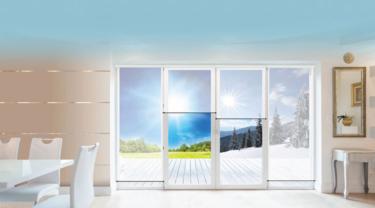You could call a case of “I liked the product so much, I bought the company.” In 2008, when a friend gave Diana Livshits solar blinds to try in her new home’s problematic west-facing windows, she and her husband couldn’t believe how perfect they were. They bought the custom blinds immediately and then sought the exclusive rights to sell them in Canada.
The product was invented by a gentleman in Windsor, but he’d since sold the company to an American group, and that’s the company Livshits and her husband dealt with for the rights. Soon after they secured them, she lost her job at Nortel and her husband, Yury Sinaniev, suggested she try launching the blind business. Krumpers Solar Blinds was soon born.
When they bought the rights, Livshits and Sinaniev subcontracted the manufacturing to a company in Toronto but soon after, they established their own manufacturing plant in Ottawa and can now boast that 95 per cent of their product is made in Canada. Meanwhile, sales have grown year over year, by between 15 and 19 per cent, since the company’s founding.
“We saw how well they worked in our own home,” Livshits said. “And for that reason, I was comfortable selling the blinds to clients; I had my own experience with them and I knew how well they worked.”
In addition to the exclusive rights in Canada, they are also allowed to sell them anywhere in the world, and thanks to effective marketing, they’ve done so since their first sale to New Zealand in 2011. Since then, they’ve sold to customers in France, Belgium, and in several states in the U.S., with California being the strongest market after a blogger there loved the product and wrote about it.
“That kind of opened the door for us in the California,” she said.
“We’re keen to grow all of our export markets,” Livshits said, and added that at this point, no other sales teams have exclusive country rights like she does in Canada, so she can sell anywhere in the world. That said, the company’s current size limits that potential somewhat, but they are working with a Mexican developer on a condo project in the Mayan Riviera.
The blinds are unique because of the way they’re made — a layer of aluminum and a layer of nano-graphite are sealed together and then perforated.
“Every hole is perforated at a different angle so that the light transmission is a similar frequency to the retinal receptors in the eye,” Livshits said. “You won’t get a headache looking through it. Then, the blind is covered with a food-grade encapsulated PVC that will provide the UV protection. It also seals the holes so dust won’t settle in them. And, best of all, this covering also adds insulating properties.”
Beyond the light transmission frequency, the angled perforations also reflect the heat. The blinds have two-sides — one for winter and one for summer. “In the summer, the aluminum side faces toward the glass to reflect the heat back outside; in winter, you change the side — which is as easy and changing a role of toilet paper — and the nano-graphite faces out and acts as a passive solar collector.”
Their laboratory tests have shown that a four-by-four-foot window will create 2096 BTUs of heat, which is equivalent to a 600-watt electric heater. The company has had three different labs test the product and they’ve reported results of between 39 and 42 per cent in energy conservation.
“And it still allows windows to do what they were meant to do, which is bring in the light,” Livshits said. “I really believe that for people to reduce energy consumption, the products they use must do so in a way that enhances their lifestyle, rather than putting up obstacles.”
Word of mouth, she said, is incredibly powerful. She also markets through social media and advertising, always by explaining the product in detail so would-be customers understand exactly what they’re buying.
“As clients change properties, we follow them along to their new houses,” she said. “Everything is custom-made. Our customers list their product as an upgrade when they sell their homes.”
Livshits said the Real Estate Board states that for every dollar you save in energy consumption, you get $3 on resale.
Get more export insights from Diana Livshits and Yuri Sinaniev here.





